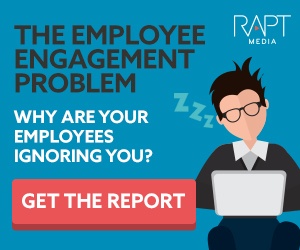It's crucial for educators to understand how students are performing, yet most of their content doesn't give them the kind of feedback they really need. Static content can't allow educators to provide viewers with tailored information that's based on their situation or knowledge level. But interactive video can.
We created an interactive video to better explain how producing content that is participatory and interactive provides an incredible advantage for both the content creator and the business persona in the e-learning space — whether it's traditional education or to educate within a company. In our new video, "E-Learning: The Interactive Advantage," join Rapt Media CEO Erika Trautman as she walks you through how interactive video can benefit e-learning.
Explore the video to learn:
- The difference between standard e-learning vs. responsive e-learning
- How you can use your video's analytics to better understand your users
- How to use interactive video to measure, analyze, iterate, and optimize content
Keep reading to learn more about these advantages, or check out the video here to get started.
Standard vs. responsive e-learning
Standard e-learning: Rapt Media's technology allows viewers to be presented only with the information that's pertinent to them. With a custom-tailored experience, you can eliminate the need for employees or students to spend time watching content that is not relevant, thereby reducing the overall time required for learning.
For example, in a video we did with The Learning Care Group, showcased in our "Interactive Advantage" video, the user selects whether they're over or under the age of 26. If they are under, the user is given information that's relevant to their specific situation before moving on to the next question. This example takes place all within the video frame and is what we call a standard e-learning interactive experience.
Responsive e-learning: A responsive experience, on the other hand, uses Rapt Media's API to allow learning to extend beyond the video frame to the entire canvas that is the Web page.
In our "Interactive Advantage" video, you'll see an example where the user chooses which planet they would like to learn about by clicking the interactive model of the solar system within the video. The surrounding site then responds by loading background imagery and displaying more information to the right of the video.
Extending this, questions can be posed in the video and feedback can be supplied with explanations as to why an answer is correct or incorrect.
The power of analytics
Rapt Media tracks each viewer interaction, the order of interactions and video viewing path, and how much content is consumed. We can deliver to educators individual information like whether a student or employee viewed or reviewed required content, how well he or she performed in quizzes, and how long it took him or her to complete the desired action.
At the same time, we can aggregate the data, so educators can see where the majority of participants are struggling or succeeding. With this feedback, instructors can modify and optimize curricula through our editor to improve outcomes.
If you're already using software systems like Web analytics, CRMs, LMSs, marketing automation software, and custom backend data systems, we can feed your user data into them using our API. By plugging the video data into your chosen analytics system, we can provide a full performance assessment both upstream and downstream of the video.
The virtuous cycle: measurement, analysis, iteration, optimization
Because interactive video is modular in nature, teachers can swap out clips one at a time based on analytical feedback and course performance. This creates a powerful virtuous cycle: create and publish interactive video content, track user interaction with the content, and modify the content to improve results.
If you already have a linear video, you can quickly turn it into an interactive experience for your students or employees. And as new material is created, updating content is as simple with swapping out one clip for another.
In an age where attention spans are dwindling more and more each year, it's no surprise that 60 percent of people say they prefer video over reading text, according to Adweek's SocialTimes blog. The shift from traditional content to digital is here, but it doesn't have to be difficult. Powerful tools are only powerful if they're easy to adopt. Our drag-and-drop authoring tool makes creative control over content intuitive and easy to understand.
Accessible everywhere
Mobile and video are self-reinforcing trends. Today, over 20 percent of video views are happening on mobile devices — a trend that continues to grow. Because Rapt Media is built entirely in HTML5, it can support any aspect ratio, any resolution, and all modern devices. Yes, that includes mobile.
This is especially important, not just to future-proof your business in the face of the demographic shift towards the highly-connected, highly-mobile millennial audience, but also because browsers like Chrome and Firefox are migrating away from Flash support.
Interactive video is a container for any possible media type that can facilitate learning, including images, audio, 3D interactive objects and beyond. At Rapt Media, we're dedicated to building technology that unlocks the communication skills of our customers, providing the best medium for learning, training and coaching.
Ready to see all of this in action? Explore the interactive experience here.




